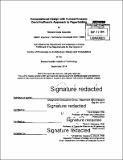| dc.contributor.advisor | Terry Knight and Erik D. Demaine. | en_US |
| dc.contributor.author | Koschitz, Richard Duks | en_US |
| dc.contributor.other | Massachusetts Institute of Technology. Department of Architecture. | en_US |
| dc.date.accessioned | 2015-01-20T17:53:57Z | |
| dc.date.available | 2015-01-20T17:53:57Z | |
| dc.date.copyright | 2014 | en_US |
| dc.date.issued | 2014 | en_US |
| dc.identifier.uri | http://hdl.handle.net/1721.1/93013 | |
| dc.description | Thesis: Ph. D. in Architecture: Design and Computation, Massachusetts Institute of Technology, Department of Architecture, 2014. | en_US |
| dc.description | Cataloged from PDF version of thesis. | en_US |
| dc.description | Includes bibliographical references (pages 385-393). | en_US |
| dc.description.abstract | This dissertation provides a new framework for defining design approaches with curved creases by investigating the work of David A. Huffman, famous computer scientist and pioneer of curved-crease paperfolding. The history of curved folding has diverse cultural origins. I outline the boundaries of curved-crease paperfolding as a field of knowledge beyond geometry by identifying its role in art, design and pedagogy. I document Huffman's entire curved-crease work, including approximately 2000 notes on geometry and 150 unique designs, and analyze it by means of a taxonomy divided into geometric categories. I abstract his designs into gadgets, or small sets of curves with specific three-dimensional folding consequences. The taxonomy begins with reflected cylinders and cones which are well understood mathematically. The bulk consists of gadgets Huffman invents for himself which use conics and refraction. The gadgets control the behavior of the paper around the crease, providing an opportunity for discrete representation. More general curve types conclude the taxonomy. This structure allows me to present Huffman's varied oeuvre in a coherent way, raise questions for future research in geometry and describe Huffman's ways of designing with constraints, making the work accessible to mathematicians as well as designers. The dissertation strives to expand the field of design and computation to include curved-crease paperfolding. I create a new framework that formalizes digital and analog design approaches, expanding on the works of Huffman and others such as Josef Albers, Roy lwaki and Ron Resch. I compare and evaluate each approach in terms of the necessary tacit versus a priori knowledge of geometry, whether they are material-driven or digitally-driven, and their use of digital representation. Since a discrete representation is available for simulation I propose a computational approach that provides real-time feedback. I present results of seminars and workshops I have conducted. Curved creases have become increasingly attractive for designers and architects as manufacturing of furniture and building parts with them has become possible. Folding flat materials provides economic and energy efficiencies compared to stamping. Making design approaches for curved creases accessible provides material-based approaches for design pedagogy and allows designers to expand their canon of forms. | en_US |
| dc.description.statementofresponsibility | by Richard Duks Koschitz. | en_US |
| dc.format.extent | 393 pages | en_US |
| dc.language.iso | eng | en_US |
| dc.publisher | Massachusetts Institute of Technology | en_US |
| dc.rights | M.I.T. theses are protected by copyright. They may be viewed from this source for any purpose, but reproduction or distribution in any format is prohibited without written permission. See provided URL for inquiries about permission. | en_US |
| dc.rights.uri | http://dspace.mit.edu/handle/1721.1/7582 | en_US |
| dc.subject | Architecture. | en_US |
| dc.title | Computational design with curved creases : David Huffman's approach to paperfolding | en_US |
| dc.type | Thesis | en_US |
| dc.description.degree | Ph. D. in Architecture: Design and Computation | en_US |
| dc.contributor.department | Massachusetts Institute of Technology. Department of Architecture | |
| dc.identifier.oclc | 899212431 | en_US |
